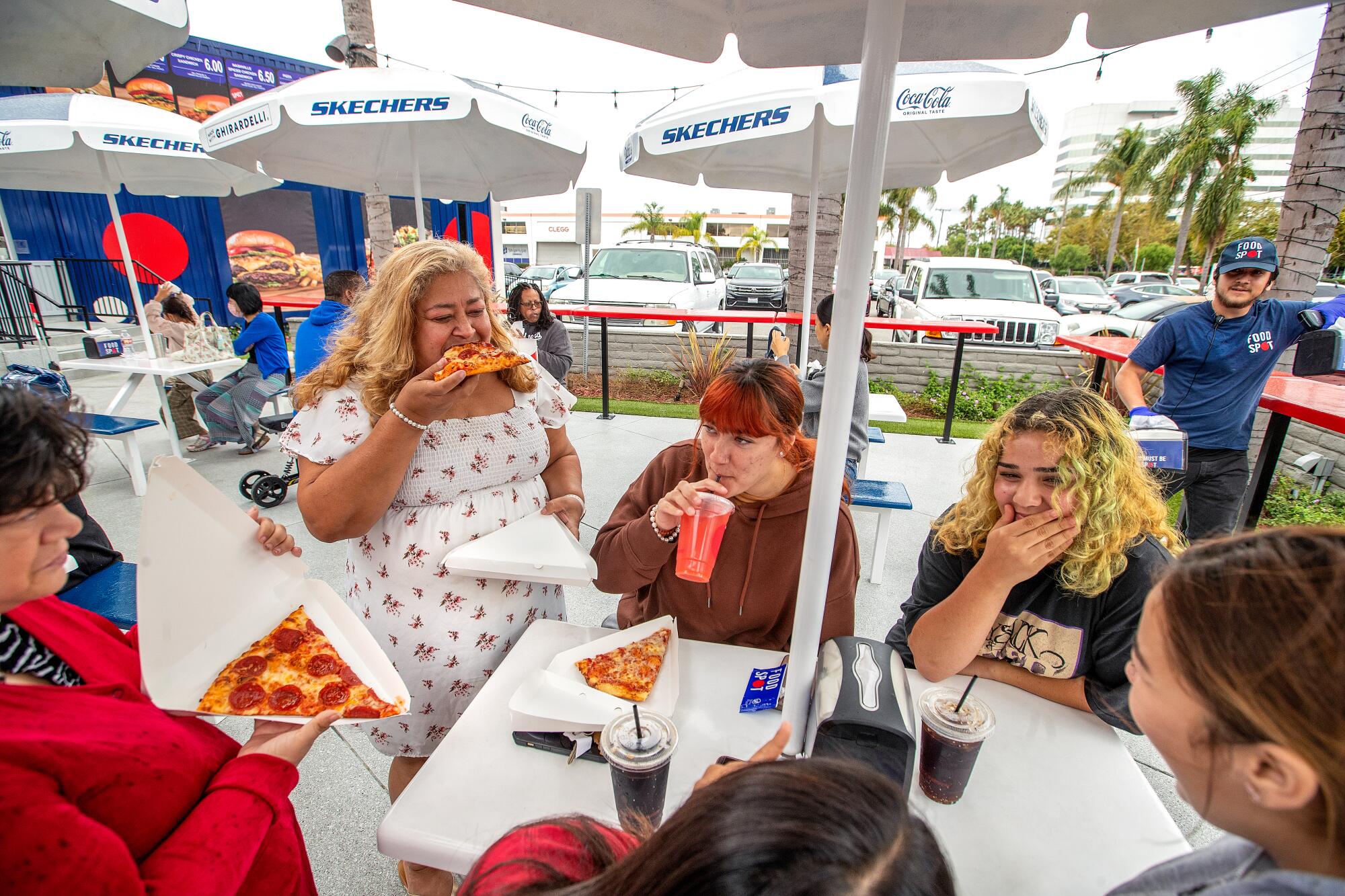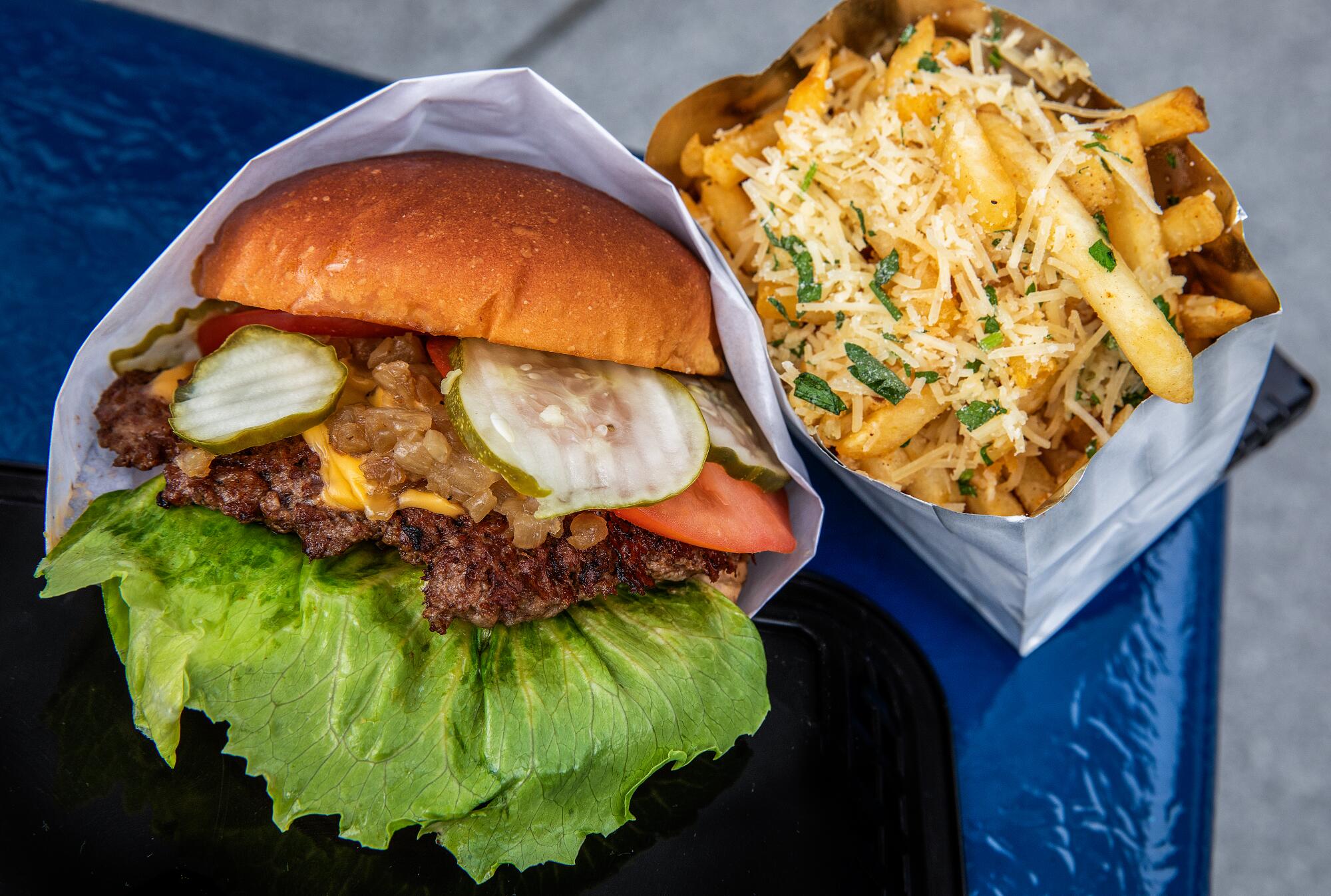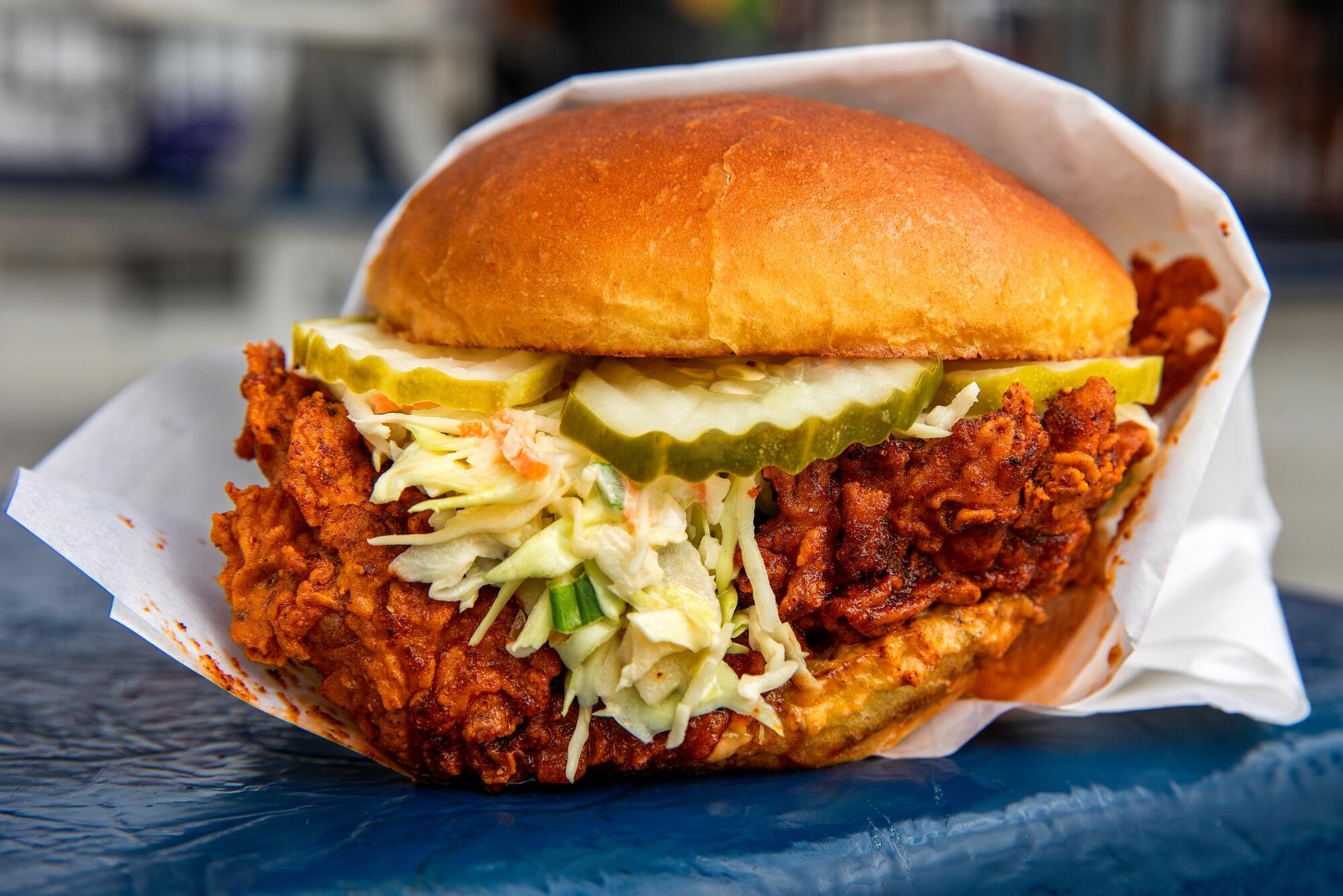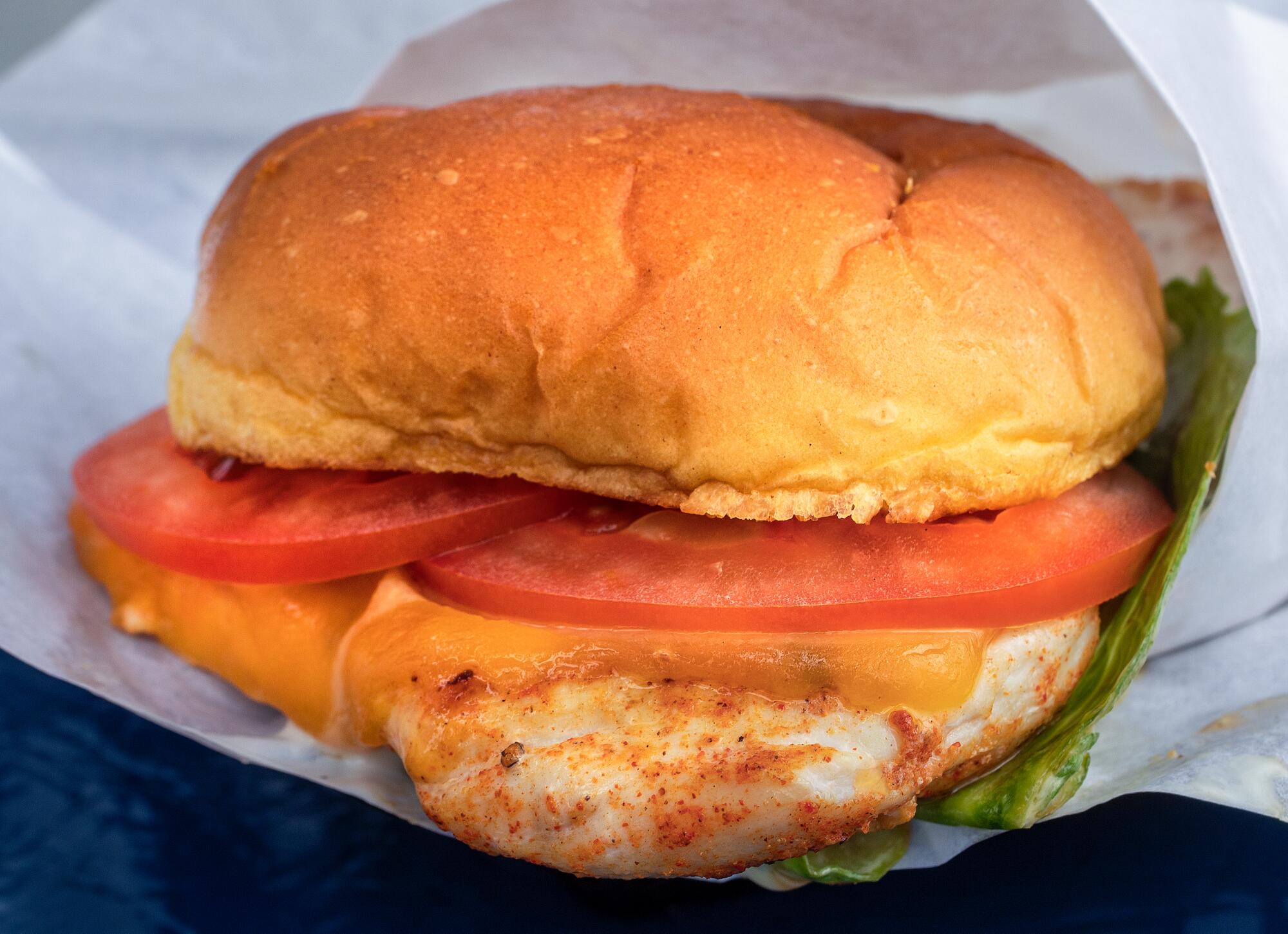Business
A Skechers food court? Yes, I’d like fries with those sneakers

A hipster barbershop that offers you a free beer while you wait. The diner that’s attached to the Galpin auto dealership in the Valley. Most of us enjoy pleasant surprises. And surprise food — food when your brain has told you not to expect food — sits at the top, or near the top, of that category.
I used to go to a place called Oasis Cafe in Chicago, which was a small restaurant hidden in the back of a jewelry store. And let me tell you: The food tasted twice as good because I was sitting in the back of a jewelry store.
Part of what makes the new Skechers Food Spot so much fun is that it isn’t supposed to be there. The outdoor food court, attached to the cavernous Skechers shoe outlet in Gardena (and Skechers’ second-ever store) opened in May and has received an onslaught of local media. Like the part of our brains that processes irony, or finds certain jokes funny, there’s a certain level of cognitive dissonance that makes Skechers Food Spot appealing. A restaurant at a shoe outlet — don’t you just instinctively want to try it?
I’ve never thought about Skechers seriously and I’m not even sure I could have spelled “Skechers” correctly a few months ago. But I’ve now been to a Skechers three times in one week. Pretty ingenious marketing.
Clockwise from top left: The Nashville spiced crispy sandwich, churros, citrus chile roast chicken sandwich, spot double cheeseburger and Manhattan Beach Cobb are on the menu at Skechers Food Spot.
(Mel Melcon / Los Angeles Times)
Here’s a quick synopsis of the experience: There’s a Skechers store in Gardena that‘s so close to the 405 Freeway, it’s practically an off-ramp. Attached to, but separate from, that store, is Food Spot.
It’s outdoors, around the corner from the store entrance. Once there, you line up in front of one window and pick your food up in front of another. There are large advertisements featuring Martha Stewart and Clayton Kershaw, who is modestly credited as “professional pitcher.”
There is a playlist pumping as you wait, and it is very eclectic. There are picnic tables with umbrellas for diners as well as a long, red counter and a condiment station. It’s a pretty fun environment.
Skechers, the Manhattan Beach-based brand founded in 1992, has grown into one of the largest footwear companies in the country. It’s also been, at times, accused by other shoe brands, like Nike and Adidas, of ripping off their designs. (Skechers appeared to emerge victorious in at least one prominent dispute that involved Converse’s Chuck Taylor shoe.)
This is only germane because my first thought upon pulling up to Food Spot was, “Oh, this reminds me a lot of Costco.”
There are similarities, specifically with the menu and how it’s displayed. At Costco’s food courts, items are pictured, oversized, on red-bordered posters with the description and price lettered below in blue on a white background. At Food Spot, they’re displayed in that style, but with the description lettered above in white, on a blue background. This was all funny enough, until a colleague showed me a photo from when Food Spot first opened, when the menu looked almost identical to that of Costco’s, with blue-on-white lettering below the food items on red-bordered posters. At some point, they changed it out.
I’m not calling Food Spot a Costco rip-off — I think healthy competition is welcome and necessary in the realm of bargain comfort food, and I’m sure the Skechers legal team is quite capable in terms of knowing how far they can push an envelope. But where there are similarities, comparisons will naturally be drawn. And in the words of Omar Little, “You come at the king, you best not miss.” (And it should be noted that Costco requires a paid membership to eat at its food court. Food Spot has no such requirement.)

Diners enjoy pepperoni pizza at the Skechers Food Spot in Gardena.
(Mel Melcon / Los Angeles Times)

“Shopping and food certainly go hand in hand,” said Skechers President Michael Greenberg. Above, an order of churros.
(Mel Melcon / Los Angeles Times)
There’s good news and bad news, as far as that goes. The bad news is that with menu items that Costco also serves, the comparison is largely unfavorable for Food Spot. The good news is that with some other items — things that Costco doesn’t offer — Food Spot really excels.
The most prominent overlap is with the hot dog, pizza, soft serve and churros. Costco wins here, as far as quality and value. Food Spot’s all-beef hot dog, provided by Nathan’s Famous, is generous, with a good snap. There are also raw onions available — a huge plus. But the $2.50 price can’t compete with the near-folkloric nature of the $1.50 Costco combo.
A sundae made with vanilla soft serve is less creamy than icy and doesn’t really do the trick at $4. The chocolate soft serve, with deep chocolate flavor, is much better.
The pizza, unfortunately, is a miss. Pepperoni and cheese slices, at $3 and $2.50, respectively, are more school cafeteria than Mulberry Street.
Now for the silver lining. The double cheeseburger is very good. Patties with nicely browned edges will send you running to look up the definition of “Maillard reaction.” Pickles, diced grilled onions and plenty of American cheese as lubricant puts this up there with your favorite smash burger. And at just $5, it gives the Double-Double a run for its money.

The Spot double cheeseburger and garlic Parmesan fries are a highlight.
(Mel Melcon / Los Angeles Times)
Three chicken sandwiches are on offer. The best of the bunch is the citrus chile roast chicken sandwich, well seasoned and simply dressed with cheddar, tomato, lettuce and a splodge of ranch dressing. The fried chicken sandwiches, one of which is “Nashville spiced,” are tasty enough but have a serious flaw, albeit one that’s completely correctable.
The coating fell right off of the chicken sandwiches I had, leaving the fillets naked as the day they were hatched. This can be due to the fact that there’s too much moisture on the chicken before it’s fried. It’s an easy fix, and one that will leave Food Spot with a couple of primo chicken sandwich options.
There’s a requisite Caesar salad, but the Manhattan Beach Cobb is more interesting: There are the expected bacon, chicken and cheese, but the inclusion of rows of corn and black olives give the salad a fun and slightly surprising dimension. The salad is blessedly free of hard-boiled egg, a welcome development in the Cobb salad sphere I hope to see repeated elsewhere.

The Nashville spiced crispy sandwich.
(Mel Melcon / Los Angeles Times)

The Manhattan Beach Cobb. Notice the absence of hard-boiled egg.
(Mel Melcon / Los Angeles Times)
The lesson here? Don’t try to beat Costco at its own game. Food Spot is at its best when offering something different.
Skechers President and co-founder Michael Greenberg, who has experience in the restaurant industry (Fresh Brothers, Rock & Brews) first conceived of this project more than two years ago. But why open a restaurant at Skechers?
“Let me start with, why not?” Greenberg said. With the busyness of the Gardena store, he said it was the perfect place to try out an idea like Food Spot. Citing retailers with food options like Ikea, Bass Pro Shops and Scheels, Greenberg said he was interested in enhancing the customer experience. “Shopping and food certainly go hand in hand,” he said.
Greenberg said Skechers worked with Sysco to develop Food Spot’s menu. Many French fry shapes were sampled, from steak to skinny. Some ideas, like a Philly cheesesteak and a calzone-like chicken pie, were left on the cutting room floor.
“We didn’t just slap this together, we put a lot of thought into doing it right,” he said.

Service is outdoors at a window, around from the shoe store’s entrance.
(Mel Melcon / Los Angeles Times)

Citrus chile roast chicken sandwich at the Skechers Food Spot.
(Mel Melcon / Los Angeles Times)
As for the recent changes made regarding the look of the menu, Greenberg said, “In anything we do, we make improvements.” He also doesn’t see Food Spot as a direct competitor to the food courts at places like Costco. “If you’re at Skechers, we’re not pulling from anybody else,” he said.
Greenberg said Food Spot has been “over-the-top busy,” and has exceeded 2,500 orders in a single day, which has him considering the possibility of expanding Food Spot beyond the Gardena location.
I can confirm it is certainly busy. In fact, if you’re visiting Food Spot during your lunch hour, you’d better take the entire hour. Things can move slowly, as they did during one visit where I spent around 10 minutes in line and then another 20 minutes waiting for my food. The staff are uniformly helpful and friendly (and they all wear Skechers — I asked), but they may need a few more hands to keep things running smoothly.
After eating, I decided to go around into the enormous retail portion of the complex to look at shoes. And that, it seems to me, is the great victory of Food Spot: Getting folks like me who’ve never worn Skechers to wander into the store. Someone on our Food team said they’d once heard something to the effect of, “Skechers are either for old people or for children.”
But who knows? Maybe they’re for me. They look pretty comfortable. I might pick up a pair on my next lunch break.
Skechers Food Spot
19000 S Vermont Ave, Gardena, (424) 271-2361, https://local.skechers.com/ca/gardena/1381/
Prices: $2.50-$7
Details: 10 a.m. to 8 p.m. Monday through Saturday, 10 a.m. to 7 p.m. Sunday
Recommended dishes: Spot double cheeseburger, citrus chile roast chicken sandwich, Manhattan Beach Cobb salad, garlic parmesan fries

Business
How Poshmark Is Trying to Make Resale Work Again

Lauren Eager got into thrifting in high school. It was a way to find cheap, interesting clothes while not contributing to the wastefulness of fast fashion.
In 2015, in her first year of college, she downloaded the app for Poshmark, a kind of Instagram-meets-eBay resale platform. Soon, she was selling as well as buying clothes.
This was the golden age of online reselling. In addition to Poshmark, companies like ThredUp and Depop had sprung up, giving a second life to old clothes. In 2016, Facebook debuted Marketplace. Even Goodwill got into the action, starting a snazzy website.
The platforms tapped into two consumer trends: buying stuff online and the never-gets-old delight of snagging a gently used item for a fraction of the original cost. During the Covid-19 pandemic, as people cleaned out their closets, enthusiasm for reselling intensified. It was so strong that Poshmark decided to go public. On the day of its initial public offering in January 2021, the company’s market value peaked at $7.4 billion, roughly the same as PVH’s, the company that owns Calvin Klein and Tommy Hilfiger, at the time.
Then, the business of old clothes started to fray.
Using the Poshmark app, Ms. Eager and others said, started to feel like trying to find something in a messy closet. The app was cluttered with features that did not work or that she did not use, and it felt “spammy,” she said, sending too many push notifications.
Many platforms found selling used items hard to scale. Now, online resellers are trying to recalibrate. Last year, ThredUp decided to exit Europe and focus on selling in the United States. Trove, a company that helps brands like Canada Goose and Steve Madden resell their goods, purchased a competitor, Recurate. The RealReal, a luxury consignor, appointed a new chief executive as the company tried to improve profitability.
Poshmark is undergoing perhaps the biggest reinvention. In 2023, Naver, South Korea’s biggest search engine as well as an online marketplace, bought the company in a deal valued at $1.6 billion, less than half its IPO price.
Something of a mash-up of Google and Amazon, Naver is betting it can rebuild Poshmark, which has 130 million active users, with the same technology that made Naver dominant in its own country.
It may also help breathe new life into the resale market. Analysts think the resale fashion market still has room to grow in the United States, with revenue expected to increase 26 percent to $36.3 billion by 2028, according to the retail consultancy firm Coresight Research.
New legislation in California could help. The law, passed last year, requires brands and retailers that operate in the state and generate at least $1 million to set up a “producer responsibility organization” to collect and then reuse, repair or recycle its products. Resale platforms like ThredUp and Poshmark could be in a position to help brands carry out that mandate.
At the moment, though, Naver’s focus for Poshmark is more basic: Make it a better place to sell and shop. The company has the “operating know-how” to do that, said Philip Lee, a founder of the media outlet The Pickool, which covers both South Korean and U.S. tech companies.
“They’re trying to renovate Poshmark and then expand the market share,” he said.
A Marriage of Search and Commerce
Poshmark, which is based in Redwood City, Calif., was founded in 2011 by Manish Chandra, an entrepreneur and former tech executive, and three others. In trying to expand, Poshmark faced a problem common to resellers: Capturing the excitement of the secondhand-shopping treasure hunt while not frustrating buyers with an endless scroll. The company knew it needed better search, as well as interactive elements that gave people more reasons to come beyond paying $19 for a J. Crew sweater.
For its part, Naver was looking for ways to push beyond South Korea, where its commerce and search businesses were already mature. The growing online resale market in the United States presented an opportunity, and also gave the company access to the largest consumer market in the world.
“Commerce is a big growth engine for us,” Namsun Kim, Naver’s chief financial officer, said. And the peer-to-peer sector, where users sell to one another, was still in its infancy, with room to expand. But, Mr. Kim added, “it’s a more challenging segment, and that’s why it’s harder for a lot of the larger players to enter.”
There are two common business models for resale: peer-to-peer and consignment. With consignment, a platform collects and redistributes physical goods. Poshmark uses the peer-to-peer model, which relies on scores of people — many of them novices — haggling over prices and then mailing items to one another. This decentralization can be a headache for brands, which like to maintain a certain level of control of their products. And platforms like Poshmark must make buyers comfortable with trusting the sellers on their site.
Before the Naver purchase, it was difficult to push through needed technological changes, said Vanessa Wong, the vice president of product at Poshmark.
“I would always talk to my engineers and ask, ‘What if we do this or do that?’ They’re like, ‘That’s hard. The effort’s really high,’” Ms. Wong said.
Naver’s purchase offered both the investment and the expertise to pull off the changes. Founded in 1999, the company is everywhere in South Korea.
“We are not just a simple search technology or A.I. service,” said Soo-yeon Choi, the chief executive of Naver, whose headquarters are near Seoul. The company, she said, “alleviates the frustrations of people, which is what is needed to help growth.”
Search built Naver “into the massive power that they are in Korea,” said Mr. Chandra, who stayed on as chief executive after Naver’s purchase. It was the top priority when the company bought Poshmark.
Several new elements for users and sellers have been introduced. With a tool called Posh Lens, users can take a photo of an item and, using Naver’s machine-learning technology, the site populates listings that are the same or similar to the shoe or tank top that they’re searching for. A paid ad feature for sellers called “Promoted Closet,” pushes listings higher on customer feeds.
Poshmark also introduced live shows, some of which are themed, to draw in the TikTok generation and increase engagement. One party auctioned off clothing previously worn by South Korean celebrities, a connection that was made with the help of Naver.
Still, the resale market is going through growing pains and has not quite found its footing since the height of the pandemic. It’s not clear whether the changes taking place at Poshmark will be enough. In May, Mr. Kim, Naver’s finance chief, said in an earnings call that Poshmark’s profitability was improving, but by November, the company was cautioning that growth had slowed because of weakness in the peer-to-peer resale market in North America.
Missteps and Reinvention
The company has already done some backpedaling on unpopular decisions.
In October, Poshmark introduced a new fee structure, which increased costs for buyers. Sellers, fearing that higher costs would make consumers bolt, revolted. Within weeks, the company scrapped the new fee structure.
And there are still user headaches: tags and keywords that help users find what they’re looking for can be miscategorized. Sellers sometimes tag their products incorrectly to get more eyeballs on their less popular products. (Hard-to-offload Amazon leggings, for example, may be listed as Free People apparel.)
The company is beta testing changes with its frequent sellers — people like Alex Mahl, who sells thousands of dollars in apparel on the site each year. And within dedicated Facebook groups related to Poshmark, there’s a lot of chatter about the changes that sellers and buyers would still like to see.
“The only way for it to do well is there’s going to be constant changes,” Ms. Mahl said about the tweaks on Poshmark. “If you were just on an app that never changed — one, it would be boring, and two, the opportunity to just do better wouldn’t be there.”
One recent morning, Ms. Eager, the seller who joined Poshmark back in college, was pleasantly surprised to find that the app had some new features she actually liked. She snapped a photo of her Aerie gray tank top with Posh Lens. Within seconds, the app populated listings of similar products. It was so much better than conjuring up the adjectives needed to describe it.
“Love it,” Ms. Eager exclaimed.
Business
When receipts of home renovations are lost, is the tax break gone too?

Dear Liz: I have sold my family home recently after almost 50 years. I had done lots of improvements throughout those years. Due to a fire 15 years ago, all the documentation for these improvements has been destroyed. How do I document the improvements for the capital gains tax calculation?
Answer: As you probably know, you can exclude $250,000 of capital gains from the sale of a principal residence as long as you own and live in the home at least two of the previous five years. The exclusion is $500,000 for a couple.
Once upon a time, that meant few homeowners had to worry about capital gains taxes on the sale of their home. But the exclusion amounts haven’t changed since they were created in 1997, even as home values have soared. Qualifying home improvements can be used to increase your tax basis in the home and thus decrease your tax bill, but the IRS probably will demand proof of those changes should you be audited.
You could ask any contractors you used who are still in business if they will provide written verification of the work they performed, suggests Mark Luscombe, principal analyst for Wolters Kluwer Tax & Accounting. You also could check your home’s history with your property tax assessor to see if its assessment was adjusted to reflect any of the improvements.
At a minimum, prepare a list from memory of the improvements you made, including the year and the approximate cost. If you don’t have pictures of the house reflecting the changes, perhaps friends and relatives might. This won’t be the best evidence, Luscombe concedes, but it might get the IRS to accept at least some increase in your tax basis.
If you’re a widow or widower, there’s another tax break you should know about. At least part of your home would have gotten a step-up in tax basis if you were married and your co-owner spouse died. In most states, the half owned by the deceased spouse would get a new tax basis reflecting the home’s current market value. In community property states such as California, both halves of the house get this step-up. A tax pro can provide more details.
Other homeowners should take note of the importance of keeping good digital records. While documents may not be lost in a fire, they may be misplaced, accidentally discarded or (in the case of receipts) so faded they’re illegible. To make sure documents are available when you need them, consider scanning or taking photographs of your records and keeping multiple copies, such as one set in your computer and another in a secure cloud account.
When an employee is misclassified as contractor
Dear Liz: A parent recently wrote to you about a son who was being paid as a contractor. I know someone else who got a job that did not “take out taxes from his paycheck.” Such workers believe they are pocketing more money, but unfortunately, too many do not know about the nature of withholding. They only learn if they choose to file for their expected refund, but instead discover an exorbitant tax liability that a paycheck-to-paycheck worker cannot pay.
The sad fact is that many of these employers improperly classify their workers, who are truly employees, as independent contractors! And they do this to avoid paying their own portion of Social Security and unemployment taxes and also workers compensation insurance.
If workers believe that they have been misclassified (the IRS website provides all criteria), they can file IRS Form SS-8 and Form 8919, which will allow them to pay only their allocated half of their Social Security taxes. Hopefully the IRS will then contact these employers to correct their wrong classifications. And finally, it should be a law that, when hired, all true independent contractors should be given a clear form (not fine print on their employment agreements) that informs them of their status and the need to make estimated tax payments.
Answer: A big factor in determining whether a worker is an employee or contractor is control. Who controls what the worker does and how the worker does the job? The more control that’s in the employer’s hands, the more likely the worker is an employee.
However, the IRS notes that there are no hard and fast rules and that “factors which are relevant in one situation may not be relevant in another.”
The form you mentioned, IRS Form SS-8, also can be filed by any employer unsure if a worker is properly classified.
Liz Weston, Certified Financial Planner®, is a personal finance columnist. Questions may be sent to her at 3940 Laurel Canyon, No. 238, Studio City, CA 91604, or by using the “Contact” form at asklizweston.com.
Business
Inside Elon Musk’s Plan for DOGE to Slash Government Costs

An unpaid group of billionaires, tech executives and some disciples of Peter Thiel, a powerful Republican donor, are preparing to take up unofficial positions in the U.S. government in the name of cost-cutting.
As President-elect Donald J. Trump’s so-called Department of Government Efficiency girds for battle against “wasteful” spending, it is preparing to dispatch individuals with ties to its co-leaders, Elon Musk and Vivek Ramaswamy, to agencies across the federal government.
After Inauguration Day, the group of Silicon Valley-inflected, wide-eyed recruits will be deployed to Washington’s alphabet soup of agencies. The goal is for most major agencies to eventually have two DOGE representatives as they seek to cut costs like Mr. Musk did at X, his social media platform.
This story is based on interviews with roughly a dozen people who have insight into DOGE’s operations. They spoke to The Times on the condition of anonymity because they were not authorized to speak publicly.
On the eve of Mr. Trump’s presidency, the structure of DOGE is still amorphous and closely held. People involved in the operation say that secrecy and avoiding leaks is paramount, and much of its communication is conducted on Signal, the encrypted messaging app.
Mr. Trump has said the effort would drive “drastic change,” and that the entity would provide outside advice on how to cut wasteful spending. DOGE itself will have no power to cut spending — that authority rests with Congress. Instead, it is expected to provide recommendations for programs and other areas to cut.
But parts of the operation are becoming clear: Many of the executives involved are expecting to do six-month voluntary stints inside the federal government before returning to their high-paying jobs. Mr. Musk has said they will not be paid — a nonstarter for some originally interested tech executives — and have been asked by him to work 80-hour weeks. Some, including possibly Mr. Musk, will be so-called special government employees, a specific category of temporary workers who can only work for the federal government for 130 days or less in a 365-day period.
The representatives will largely be stationed inside federal agencies. After some consideration by top officials, DOGE itself is now unlikely to incorporate as an organized outside entity or nonprofit. Instead, it is likely to exist as more of a brand for an interlinked group of aspirational leaders who are on joint group chats and share a loyalty to Mr. Musk or Mr. Ramaswamy.
“The cynics among us will say, ‘Oh, it’s naïve billionaires stepping into the fray.’ But the other side will say this is a service to the nation that we saw more typically around the founding of the nation,” said Trevor Traina, an entrepreneur who worked in the first Trump administration with associates who have considered joining DOGE.
“The friends I know have huge lives,” Mr. Traina said, “and they’re agreeing to work for free for six months, and leave their families and roll up their sleeves in an attempt to really turn things around. You can view it either way.”
DOGE leaders have told others that the minority of people not detailed to agencies would be housed within the Executive Office of the President at the U.S. Digital Service, which was created in 2014 by former President Barack Obama to “change our government’s approach to technology.”
DOGE is also expected to have an office in the Office of Management and Budget, and officials have also considered forming a think tank outside the government in the future.
Mr. Musk’s friends have been intimately involved in choosing people who are set to be deployed to various agencies. Those who have conducted interviews for DOGE include the Silicon Valley investors Marc Andreessen, Shaun Maguire, Baris Akis and others who have a personal connection to Mr. Musk. Some who have received the Thiel Fellowship, a prestigious grant funded by Mr. Thiel given to those who promise to skip or drop out of college to become entrepreneurs, are involved with programming and operations for DOGE. Brokering an introduction to Mr. Musk or Mr. Ramaswamy, or their inner circles, has been a key way for leaders to be picked for deployment.
That is how the co-founder of Loom, Vinay Hiremath, said he became involved in DOGE in a rare public statement from someone who worked with the entity. In a post this month on his personal blog, Mr. Hiremath described the work that DOGE employees have been doing before he decided against moving to Washington to join the entity.
“After 8 calls with people who all talked fast and sounded very smart, I was added to a number of Signal groups and immediately put to work,” he wrote. “The next 4 weeks of my life consisted of 100s of calls recruiting the smartest people I’ve ever talked to, working on various projects I’m definitely not able to talk about, and learning how completely dysfunctional the government was. It was a blast.”
These recruits are assigned to specific agencies where they are thought to have expertise. Some other DOGE enrollees have come to the attention of Mr. Musk and Mr. Ramaswamy through X. In recent weeks, DOGE’s account on X has posted requests to recruit a “very small number” of full-time salaried positions for engineers and back-office functions like human resources.
The DOGE team, including those paid engineers, is largely working out of a glass building in SpaceX’s downtown office located a few blocks from the White House. Some people close to Mr. Ramaswamy and Mr. Musk hope that these DOGE engineers can use artificial intelligence to find cost-cutting opportunities.
The broader effort is being run by two people with starkly different backgrounds: One is Brad Smith, a health care entrepreneur and former top health official in Mr. Trump’s first White House who is close with Jared Kushner, Mr. Trump’s son-in-law. Mr. Smith has effectively been running DOGE during the transition period, with a particular focus on recruiting, especially for the workers who will be embedded at the agencies.
Mr. Smith has been working closely with Steve Davis, a collaborator of Mr. Musk’s for two decades who is widely seen as working as Mr. Musk’s proxy on all things. Mr. Davis has joined Mr. Musk as he calls experts with questions about the federal budget, for instance.
Other people involved include Matt Luby, Mr. Ramaswamy’s chief of staff and childhood friend; Joanna Wischer, a Trump campaign official; and Rachel Riley, a McKinsey partner who works closely with Mr. Smith.
Mr. Musk’s personal counsel — Chris Gober — and Mr. Ramaswamy’s personal lawyer — Steve Roberts — have been exploring various legal issues regarding the structure of DOGE. James Burnham, a former Justice Department official, is also helping DOGE with legal matters. Bill McGinley, Mr. Trump’s initial pick for White House counsel who was instead named as legal counsel for DOGE, has played a more minimal role.
“DOGE will be a cornerstone of the new administration, helping President Trump deliver his vision of a new golden era,” said James Fishback, the founder of Azoria, an investment firm, and confidant of Mr. Ramaswamy who will be providing outside advice for DOGE.
Despite all this firepower, many budget experts have been deeply skeptical about the effort and its cost-cutting ambitions. Mr. Musk initially said the effort could result in “at least $2 trillion” in cuts from the $6.75 trillion federal budget. But budget experts say that goal would be difficult to achieve without slashing popular programs like Social Security and Medicare, which Mr. Trump has promised not to cut.
Both Mr. Musk and Mr. Ramaswamy have also recast what success might mean. Mr. Ramaswamy emphasized DOGE-led deregulation on X last month, saying that removing regulations could stimulate the economy and that “the success of DOGE can’t be measured through deficit reduction alone.”
And in an interview last week with Mark Penn, the chairman and chief executive of Stagwell, a marketing company, Mr. Musk downplayed the total potential savings.
“We’ll try for $2 trillion — I think that’s like the best-case outcome,” Mr. Musk said. “You kind of have to have some overage. I think if we try for two trillion, we’ve got a good shot at getting one.”
-

 Politics1 week ago
Politics1 week agoCarter's judicial picks reshaped the federal bench across the country
-

 Politics1 week ago
Politics1 week agoWho Are the Recipients of the Presidential Medal of Freedom?
-

 Health1 week ago
Health1 week agoOzempic ‘microdosing’ is the new weight-loss trend: Should you try it?
-

 World1 week ago
World1 week agoSouth Korea extends Boeing 737-800 inspections as Jeju Air wreckage lifted
-
/cdn.vox-cdn.com/uploads/chorus_asset/file/25822586/STK169_ZUCKERBERG_MAGA_STKS491_CVIRGINIA_A.jpg)
/cdn.vox-cdn.com/uploads/chorus_asset/file/25822586/STK169_ZUCKERBERG_MAGA_STKS491_CVIRGINIA_A.jpg) Technology4 days ago
Technology4 days agoMeta is highlighting a splintering global approach to online speech
-

 News1 week ago
News1 week agoSeeking to heal the country, Jimmy Carter pardoned men who evaded the Vietnam War draft
-

 Science1 day ago
Science1 day agoMetro will offer free rides in L.A. through Sunday due to fires
-

 News1 week ago
News1 week agoTrump Has Reeled in More Than $200 Million Since Election Day















